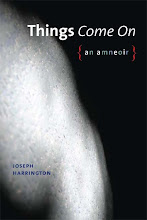I keep meaning to write some “book descriptions” (a.k.a. chickenshit pseudo-reviews) – and indeed, I have a stack of books on my desk awaiting just such a fate. But I’ve actually been too busy – a.) working on my writing or b.) getting really depressed about my writing.
But I’m going to break down and write one today – about Gilliam Conoley’s The Plot Genie – not new new (2009), but new enough, right? Anyway, this book is inspired by what I gather were a series of books by Wycliffe A. Hill (his real name?), a silent-film director who titled the series (yep) The Plot Genie. I further gather than it presented one with options for story elements at any given stage of a plot – maybe a 1930s version of hyper-fiction.
That’s what I gather – based on Conoley’s notes in the back. But it’s not a docupoem. It’s a reflection about plot and plotting – about narrative and narrativization – how we tell ourselves about ourselves accordingly – successfully or un.
There is a cast of characters: Comedy Boy, Tyger, Miss Jane Sloane, Handsome Dead Man (I “gather” this phrase actually appears in the original P.G.), Redhead, E., and R. (a couple – either more so or once again – get it?). Where one ends and another begins is sometimes in doubt.
Stories begin in these poems, only to slip into a different story and then a third, fourth, etc. – until there’s really no “story arc” at all – only arcs that form a kind of squiggly curve (or wheel – see p. 24 – I Gather that there might have been some kind of wheel device included w/the original PG – maybe as a random plot-element generator):
drain the pond to see the fish.
Or sometimes tortoises, gulls, empty vials of human growth –
maybe a messenger – a slope nosed boxer on a junket
in a satin cape. In an alley – speaking out the side of his mouth –
I am thy father’s spirit,
doomed once more and for a certain time
to walk the earth – quipped
Comedy Boy, darkening the door
And so, “with one journey finished,/ so begins another, and with another over, so starts// the next, asn on, on into//the long intolerable arc,/no hour of doom to come” (this just after a passage from The Postman Always Rings Twice - maybe they are interchangeable). It’s just one damn thing after another – which is what Hayden White would call the Ironic or Satirical mode of historiography, I reckon. Which also means there are bigger stakes, i.e.: “That’s precisely how antagonists wreck one’s mind./ To feel no identity aright except/ one first stirred/ by becoming someone else – // which does not so much relieve/ my hunger to become,// as keep it immortal in me . . .” So the storyteller and character are uncomfortably close, as is that character to all the others. If the story is a wheel, it don’t never stop. “The future is a probe, tied to its fear/ of stopped time . . .” Got to keep the story moving. So get up in the morning. I guess – anyway, I get the sense of a pathological and irresistible demand for plot – for story and more story being drawn out of - language? the subject? the author? – in this book – which I guess is what the 1001 Nights is (are) about, except that Scheherazade stays Scheherazade in that one. The end, for now.
from Startles
-
*Startles*
The land of magical thinking forsakes thought for desire, a flatter sense.
Days I want to think I drive the car; only at construction sites c...
1 day ago










